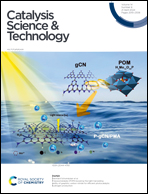“Honeycomb catalytic strategy” for carbonylation reaction based on the structural evolution of cobalt species†
Abstract
For catalytic carbonylation reactions, the high-cost catalyst recovery process is a huge challenge in industrial applications. Herein, the “honeycomb catalytic strategy” based on the structural evolution of supported cobalt catalysts successfully implements a facile and efficient catalyst recovery in the methoxycarbonylation of propylene oxide. In this strategy, cobalt species mainly exist in the form of homogeneous cobalt carbonyl species and supported cobalt nanoparticles in the reaction and product/catalyst separation stage, respectively, for reconciling catalytic efficiency and metal recovery. Our results demonstrate that catalytic behaviors of supported cobalt catalysts strongly depend on the support materials and the in situ generated cobalt carbonyls. And higher CO partial pressure and lower temperature are conducive to the conversion of metallic cobalt into cobalt carbonyls, while additional post-treatment procedures (removing CO and introducing high temperature) can recover the dissolved cobalt species in the product mixture onto the support. ICP testing proved that the optimal post-treatment process can increase the Co retention ratio of the Co/C catalyst from 45.3% to 98.9%. After four honeycomb catalytic cycles, the Co retention ratio remained at 95.2% with a slight loss of productivity. Meanwhile, for the cobalt-based catalysts with different supports and higher loadings, the post-treatment process also significantly enhanced the Co retention ratio, thereby demonstrating the effectiveness and universality of the “honeycomb catalytic strategy”.



 Please wait while we load your content...
Please wait while we load your content...